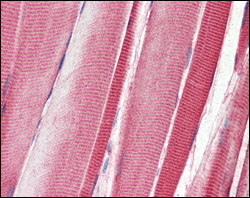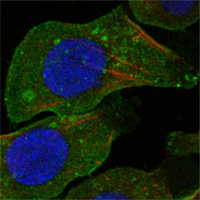DDR2 Monoclonal Antibody
- Catalog No.:YM0195
- Applications:WB;IHC;IF;ELISA
- Reactivity:Human
- Target:
- DDR2
- Gene Name:
- DDR2
- Protein Name:
- Discoidin domain-containing receptor 2
- Human Gene Id:
- 4921
- Human Swiss Prot No:
- Q16832
- Mouse Swiss Prot No:
- Q62371
- Immunogen:
- Purified recombinant fragment of human DDR2 expressed in E. Coli.
- Specificity:
- DDR2 Monoclonal Antibody detects endogenous levels of DDR2 protein.
- Formulation:
- Liquid in PBS containing 50% glycerol, 0.5% BSA and 0.02% sodium azide.
- Source:
- Monoclonal, Mouse
- Dilution:
- WB 1:500 - 1:2000. IHC 1:200 - 1:1000. IF 1:200 - 1:1000. ELISA: 1:10000. Not yet tested in other applications.
- Purification:
- Affinity purification
- Storage Stability:
- -15°C to -25°C/1 year(Do not lower than -25°C)
- Other Name:
- DDR2;NTRKR3;TKT;TYRO10;Discoidin domain-containing receptor 2;Discoidin domain receptor 2;CD167 antigen-like family member B;Discoidin domain-containing receptor tyrosine kinase 2;Neurotrophic tyrosine kinase; receptor-related 3;Re
- Molecular Weight(Da):
- 97kD
- References:
- 1. Leitinger B. Kwan AP. Matrix Biol. 2006, Aug, 25(6):355-64. Epub 2006 May 26.
2. Shyu KG. Chao YM. Wang BW. et al. Hypertension. 2005, Sep, 46(3):614-21. Epub 2005 Aug 8.
3. Neale JC. Kenny
- Background:
- Receptor tyrosine kinases (RTKs) play a key role in the communication of cells with their microenvironment. These molecules are involved in the regulation of cell growth, differentiation, and metabolism. In several cases the biochemical mechanism by which RTKs transduce signals across the membrane has been shown to be ligand induced receptor oligomerization and subsequent intracellular phosphorylation. This autophosphorylation leads to phosphorylation of cytosolic targets as well as association with other molecules, which are involved in pleiotropic effects of signal transduction. RTKs have a tripartite structure with extracellular, transmembrane, and cytoplasmic regions. This gene encodes a member of a novel subclass of RTKs and contains a distinct extracellular region encompassing a factor VIII-like domain. Alternative splicing in the 5' UTR results in multiple transcr
- Function:
- catalytic activity:ATP + a [protein]-L-tyrosine = ADP + a [protein]-L-tyrosine phosphate.,function:This tyrosine kinase receptor for fibrillar collagen mediates fibroblast migration and proliferation. Contributes to cutaneous wound healing.,similarity:Belongs to the protein kinase superfamily. Tyr protein kinase family. Insulin receptor subfamily.,similarity:Contains 1 F5/8 type C domain.,similarity:Contains 1 protein kinase domain.,tissue specificity:The major 10 kDa transcript is expressed in high levels in heart and lung, less in brain, placenta, liver, skeletal muscle, pancreas, and kidney.,
- Subcellular Location:
- Cell membrane ; Single-pass type I membrane protein .
- Expression:
- Detected in osteocytes, osteoblastic cells in subchondral bone, bone lining cells, tibia and cartilage (at protein level). Detected at high levels in heart and lung, and at low levels in brain, placenta, liver, skeletal muscle, pancreas, and kidney.
- June 19-2018
- WESTERN IMMUNOBLOTTING PROTOCOL
- June 19-2018
- IMMUNOHISTOCHEMISTRY-PARAFFIN PROTOCOL
- June 19-2018
- IMMUNOFLUORESCENCE PROTOCOL
- September 08-2020
- FLOW-CYTOMEYRT-PROTOCOL
- May 20-2022
- Cell-Based ELISA│解您多样本WB检测之困扰
- July 13-2018
- CELL-BASED-ELISA-PROTOCOL-FOR-ACETYL-PROTEIN
- July 13-2018
- CELL-BASED-ELISA-PROTOCOL-FOR-PHOSPHO-PROTEIN
- July 13-2018
- Antibody-FAQs
- Products Images

- Western Blot analysis using DDR2 Monoclonal Antibody against truncated DDR2 recombinant protein.

- Immunohistochemistry analysis of paraffin-embedded human skeletal musle tissues with AEC staining using DDR2 Monoclonal Antibody.

- Confocal immunofluorescence analysis of A549 cells using DDR2 Monoclonal Antibody (green). Red: Actin filaments have been labeled with DY-554 phalloidin. Blue: DRAQ5 fluorescent DNA dye.



